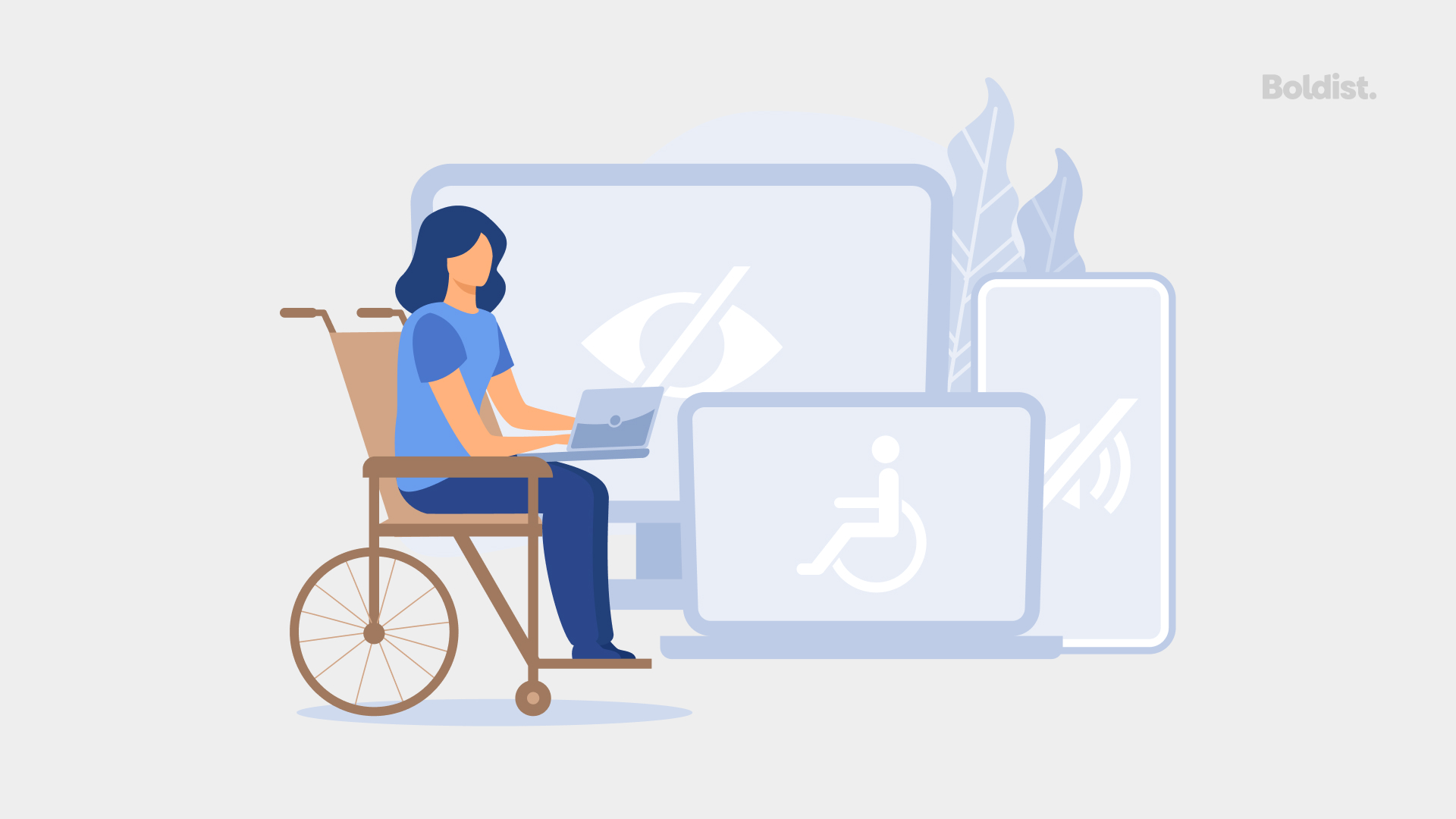Technology exists to make our lives better. It serves to help us get things done efficiently, to get us from point A to point B faster, so we have more time for what matters. At Boldist, we believe that all users deserve the chance to use these tools. This concept is called universal design, and it drives our design choices.
Accessible design is the part of universal design that grants disabled users the same ease of use as the rest of the population.
It’s an important distinction to make when the average website is three times less usable for people with a disability. A study by the Nielsen Norman Group found that the success rate for blind users completing a task through a screen reader was a mere 12.5% compared to the 78.2% achieved by non-disabled users, and blind users took more than twice as long to complete the task.
The United Nations’ Convention on the Rights of Persons with Disabilities identifies two major types of barriers to disabled individuals: environmental and attitudinal. It’s attitudinal barriers that spread an air of indifference as people with disabilities are isolated and told that their problems are their own to handle. As a result, an unjust gap in usability remains.
This isn’t how a compassionate society functions, and it’s not how you build empathetic design that opens itself to all of your users. It may be difficult to close that gap entirely due to the nature of a disability, but the online environment can be much more accessible than it is. All it takes is a commitment to researching and designing with accessibility in mind – and the benefits are significant.
Benefits of Accessible Design
According to the World Health Organization, more than 15% of the world’s population is disabled. Thus, creating accessible websites and apps means access to more paying customers. You would never ignore 15% of your target audience, but that’s precisely what designing without accessibility does.
People also get it in their heads that designing for accessibility means fewer freedoms and unattractive design. In truth, accessible design tends to look and function better, load web pages faster, and create a greater user experience for all. For example, the captions intended for a deaf user also benefit the person who forgets their headphones at home. Accessibility serves universal design.
Designing for accessibility also cuts costs and labor down the road as less time and money goes into debugging and fixing code. This same code then doubles as an SEO enhancer because search engines, like Google, understand online content in a similar way to screen readers.
With accessible design and improved user experience, you’ll enjoy a boosted reputation and the knowledge that you’ve contributed to making the digital world a better place.
And, as if you weren’t convinced already, you may be required by the Americans With Disabilities Act to make your website ADA compliant.
Disclaimer: We are not lawyers, nor are we your lawyer, so we can’t protect you from lawyers lawyering. What we can do is help you make it easier for everyone to access your website, and we think that matters.
What Is ADA Compliance?
Much like ourselves, the Department of Justice believes that access to information and communications technology is a fundamental human right, so they created the Americans With Disabilities Act (ADA). The act requires certain organizations’ websites, apps, and software to meet standards for accessible design so people with disabilities have equal access and ease of use.
You can access these standards in the WCAG 2.0 AA guidelines and include four principles:
- Perceivable: All content and UI elements can be perceived or adjusted to meet user needs without malfunctioning.
- Operable: All UI elements are operable and can be easily navigated. Completing tasks is efficient.
- Understandable: Information and UI elements are easy to understand. (Online forms are a common problem area.)
- Robust: Users or their assistive technology can interpret content.
Under these four principles are 12 guidelines, each with its own success criteria and advisory techniques for meeting that criteria. It’s important to note that user interface (UI) design is a subsegment of UX design, and you need both to create a compelling and accessible product.
And while creating UI and UX that meets ADA guidelines helps avoid legal trouble, you should want to support all of your users. This means accounting for those with sensory, cognitive, and motor disabilities.

Designing for the Blind and Visually Impaired
Traversing the digital environment is particularly challenging for the blind and visually impaired because of its visual nature. Screen readers can interpret online interfaces and read text aloud, but you need to optimize your text and code for screen reader use. Navigating text-heavy pages can be frustrating when you can’t skim content, and you’re missing design indicators or imagery that provide context.
This is where designers and developers come together to create great, readable alt text and code. Writing alt text for accessibility means knowing how to describe images and page elements clearly and with purpose. Label header tags on web pages, describe links in the text, and format elements like forms for screen readers.
So your efforts towards accessible design don’t go to waste, ensure that all browsers can read your code.
For users who are visually impaired but not blind, contrast color for visibility and make font sizes adjustable. Making these adjustments shouldn’t negatively affect the appearance of other UI elements. Using a high contrast ratio is also one of many ways to make UI design color blind friendly.
Many of these tips can and should be adapted to also create accessible marketing for the visually impaired.
Designing for the Deaf and HOH
Design for the deaf and hard of hearing community becomes more significant as multimedia elements, from gifs to videos, continue to take over content. One of the best ways to make your content accessible to the deaf is to incorporate subtitles and transcriptions for all audio.
Providing captions will also expand your potential audience to include speakers of other languages and anyone who can’t play audio out loud.
Designing for Cognitive Disabilities
Users with cognitive or neurological challenges, including ADHD, dyslexia, learning disabilities, and epilepsy, should be considered when designing your products as well.
Stick to simple language, consistent navigation, clear hierarchies within information architecture, and allow time adjustments for timed tasks. If you incorporate an internal search engine, optimize it to be forgiving of spelling errors. Making these adjustments will benefit all of your users in navigating your product, those with and without cognitive disabilities alike.
For users that have epilepsy, there are safe content guidelines you can follow to avoid triggering seizures. Flashing content is a common trigger, so it’s best practice to limit flashing to less than three times per second. Always avoid the color red in blinking content.
Designing for Motor Disabilities
Members of your user base may have a motor disability, like limited mobility or tremors, that they were born with or left with after an accident or stroke. Many of these users take advantage of assistive technology, including alternative keyboards and voice command software.
Make your designs and content accessible to users with motor disabilities by ensuring that it’s compatible with keyboard navigation and command technology. All site actions and tasks should be translatable to these devices.
Other Forms of Accessibility
People with disabilities aren’t the only ones who experience barriers to accessibility. The context in which one uses a product may affect usability in several ways. Situational limitations include sleep deprivation, being underground, being in a brightly lit environment, having limited bandwidth, or even being in a public space.
By accounting for all usability barriers, a web designer gets closer to universal design, where all users can use a product in all contexts.
Research. Design. Audit. Repeat.
Accessibility should be involved from the beginning of the design process and onwards, but it’s never too late to start. Accessibility testing is one of many UX research methods that you can use to uncover usability problems in advance. You can also create audience personas for disabled users to help you stay empathetic to their needs while designing the user experience.
Post design, regularly conduct accessibility audits on your developed products even once they are public. Ensure everything from code to alt tags and color schemes meet the standards for accessible design. The A11Y project provides excellent resources for evaluating accessibility.
When designing and auditing your digital products, assess the accessibility of your audio, color, animation, imagery, structure, controls, font, and time elements.
Make Accessible Design a Priority
We use technology daily to make our lives easier, and everyone deserves equal access to these tools. When you commit to developing accessible websites and apps, you contribute to equality while boosting your KPIs.
If you’re building a digital product or require a redesign, make accessibility a priority and reach out to the design experts.


